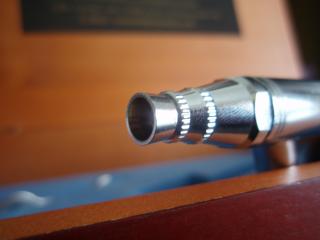Wah, long time never come here sibuk. This thread is still alive

Kevinn7, if you like to know more about auto modelling, try here:
http://z12.invisionfree.com/ScaleModelsMalaysiaor alternatively, clicking on rayloke's signature will bring you to zerogunz.
There are more people doing cars/autos there and their WIP has more info for you to learn more about making cars.
Any, I my attempt to answer some of your queries if you don't mind..
1) & 2)
I suppose you wonder the effects of paint finishing (gloss, matt, orange peel, etc) with changes in paint thinning and airbrush setting.
Ok, since 1) and 2) are related, I shall explain together.
Like what been explain, the faster the paint dry the coarser the paint dries (ie. rough, matt or flat).
The only way to get a smooth surface and glossy is a wet coat spray where you spray the plastic surface with paint until it turns "wet", but not too much until you get runny paints.
I think 10psi is too low for wet coat as the paint emmission is too slow for the paint to build up a wet-coat.
By the time it build sufficiently thick enough coat, most of the paint on the surface has dried and more paint landing on dried/semi dried surface will create a flat-look.
To get a satisfactory glossy surface, you need to get the job done fast.
How fast? Google on youtube on those car makers, you know how fast you need to work with your airbrush.
They usually spray with higher psi around 18-25, and moving the hand fast to cover as much area with paint as even and smooth.
Spraying with low psi takes longer and risk the danger of paint pooling/accumulating.
Besides, I assume you spray semi-gloss paint to get semi-gloss finishing, flat to get flat and gloss to get gloss.
Spraying on a flat/rough surface will get you a flat/semi-gloss or rough finishing despite you are spraying with a gloss paint on top. So, make your primed surface matches your finishing need.
As for thinning, it's really very versatile.
Some prefer thinner, some thicker.
Thinner paint means runnier paint and require thinner paint layer, but more layer.
Thicker paint means less layer but risk of orange peel/ paint pooling.
It's up to individual to adjust to their need. Key is practice. Get some disposable plastic spoon to practice your airbrush if you're not confident

3) For clear coat on painted surface, it's about paint on paint.
I believe you should already know the basics of paint strength (acrylics < enamel < lacquer)
Never get a stronger paint type on top of a weaker (that's why primer are usually lacquer base).
Same type paint on top of each other is OK.
And whenever you need to spray another paint (clear is also a paint) on top another paint, make sure the first spray is always a mist coat. Because a wet coat will carry sufficiently enough thinner to do much damage on the paint beneath (eg. paint smearing).
Once the first 2-3 mist coat has dried on top of the lower paint layer (say 3 mist coat of clear on a painted white surface), the successive wet coat of clear will do sufficiently damage/or so call bonding to the clear coat, but will not reach the white layer paint.
Had you skipped the mist coat step, your wet clear coat will directly react with white and get smearing all across.
4) Of course there will be vapor, so after every wet coat, always allow 1-2 days for it to "gas-out".
Try touch with your fingers, if finger print stays.. (not oily finger prints), that means your paint is still soft and not fully cured.
Wait for it to fully cure before another wet coat (if necessary).
Hope it helps

Yeah.. that website is awesome.. ehehe
1 &2) Ok. I have a clearer picture on the PSI settings now.
In terms of thinning, I think I will stick with thinner paint, sounds safer. At least until I'm comfortable taking a step higher.
3) I did not know the rule of "acrylics < enamel < lacquer" until you told me. Thanks for the heads up. hehe
I think I will go for 2 mist coats, put in my decals, another 3 mist coats and one final wet coat. Slowly sand it down with 800 then 1000 grit sandpaper and then polish. Sounds ok right?
4) I was referring to the machine pump itself that has a glass like reservoir.
I think I will leave the car for a few days without having any sort of contact, wanna play safe
ehhe...










 Mar 29 2010, 12:05 AM
Mar 29 2010, 12:05 AM
 Quote
Quote
 0.2442sec
0.2442sec
 0.84
0.84
 7 queries
7 queries
 GZIP Disabled
GZIP Disabled